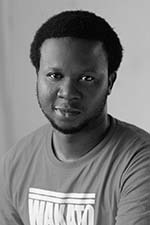Reframing Neglect
Reframing Neglect
This series, Reframing Neglect, highlights the dire need to end neglected tropical diseases (NTDs) through a collaborative body of work with photographers from seven African countries. Through a mix of fine art and documentary photography, the artists work to promote the central message that NTDs especially afflict people neglected by international systems.
This collection was curated by Aïda Muluneh, an Ethiopian photographer, contemporary artist, and activist who has captured the international art world through visual storytelling that intersects with, and elevates advocacy. In breathtakingly bold colors, she dissects social issues and challenges western representations of Africa.
This is a short sample of the body of work and the artists that created it.
For a limited time, buy a piece of Reframing Neglect.

Born in Addis Ababa in 1974, Aïda graduated with a degree from the Communication Department with a major in Film from Howard University in Washington D.C. Her photography can be found in several publications as well as the permanent collection…
Crimson Echo
The Crimson Echo is a reflection on the human toll of neglected tropical diseases (NTDs), not only on the physical manifestations of the diseases but the implication they have on the psyche of those impacted. Muluneh embeds multiple layers of narrative into each image to create a powerful interpretation of the impact of NTDs on gender equity, mental health, mobility, and access to resources. Using bright colors and respect for tradition as her vehicle, Muluneh’s work is dismantling renderings of a bleak and impoverished Africa. In essence, utilizing art as a tool to ask questions, show the unseen and provoke the onlooker to encounter the depths of our shared human emotions.


Mustafa Saeed is a Somali artist based in Hargeisa, Somalia. His work combines different mediums including photography, graphics, and sound to explore socio-political issues including war, conflict and environment…
Water..Water..Life
Somali documentary photographer and visual artist, Mustafa Saeed, focuses on dissecting the emotional turmoil that intestinal worms bring to the people whose bodies they inhabit. Through colorful ropes and garments, Mustafa conveys the neglect and feeling of being a prisoner to a disease that can easily be treated.


Sarah Waiswa is a Ugandan-born, Kenyan-based documentary and portrait photographer with an interest in exploring the New African Identity on the continent. With degrees in sociology and psychology, Sarah’s work explores social issues in Africa in a contemporary and non-traditional way…
Living with LF
In this series, Sarah Waiswa, a Ugandan-born, Kenya-based photographer follows Eunice Atieno, a 48 year old single mother, who has been living with LF since 2011. Not knowing the cause of the swelling, Eunice went from hospital to hospital trying to get a diagnosis, but failed to get an answer. At one point doctors claimed it was cancer and she even went ahead with chemotherapy, but her leg continued to swell. In 2019, she was correctly diagnosed with LF following a mass drug administration exercise that took place in her neighborhood.


Meseret Argaw was born in 1989 in Addis Ababa, Ethiopia, where she is currently based. After a degree in Textile Engineering, her passion for photography led her to study Photography and Film Making at the Master Fine Art and Vocational Center…
Neglect the “Neglect”
Ethiopian photographer Meseret Argaw explores the social, economic, and mental health impact neglected tropical diseases (NTDs) have on women living in rural communities in Ethiopia. Through conceptual pieces, she illustrates how NTDs force women into cycles of poverty. Each photograph is not directly related to a specific NTD, but the feeling behind what women with NTDs face. It could be not being able to finish the simplest everyday task, the social isolation or exclusion, the added burden of the diseases, the negative social pressure and the broken dreams they hold on to.


Ala Kheir, born in 1985, is a Sudanese photographer. He started practicing photography as a hobby while he was finishing a degree in mechanical engineering in 2005. Ala Kheir’s photography visits different parts of Khartoum in an attempt to engage with the city where he grew up…
In their place
Ala Kheir layers photos of people and places in this series. Ala highlights a neighborhood in the outskirts of Khartoum known as the Stables Industrial Area where families who fled unstable regions have made makeshift homes. The city is rapidly expanding, and poverty is clear in the periphery. People fleeing war zones find refuge in places that are not suitable to be homes. Dump yards, industrial areas, and other seemingly unsuitable areas now host huge populations trying to make temporary homes, which slowly have become integrated into the city – areas now rife with NTDs. These new neighborhoods are in all corners of the city, and it is where the majority of people living with NTDs reside.


John Moussa Kalapo was born in Bamako, Mali, in 1983. Originally trained as an accountant, in 2010 he enrolled at the Photography Training Center of Bamako where he did a conceptual-creative and art photography course…
The Neglected diseases in Mali
Malian photographer, John Kalapo, documents people living with NTDs in the Kita region of the country. Through formal portraits, he captures the physical impact of the disease while maintaining the dignity of the people he photographs. He focuses on documenting cases of river blindness and elephantiasis in the villages of Sagabary, Boukarybaye-Bohan, and in Kita town.


Omoregie Osakpolor is an emerging documentary photographer and filmmaker living in Lagos, Nigeria. He received his BA (Hons) in English and Literature from the University of Benin, Edo State. He is presently a mentee at the Nlele Institute Mentorship Programme and a member of 1884 Collective.
To the Edge and Out
Omoregie Osakpolor is an emerging documentary photographer living in Lagos, Nigeria. In this series, he documents the activities of END Fund partner, the Amen Foundation, tackling neglected tropical diseases in Gombe, Nigeria. Nigeria has one of the highest burden of NTDs in the world with over 166 million people at risk. The series illustrates the physical impact of NTDs on patients and how health workers are tackling NTDs in their communities.

